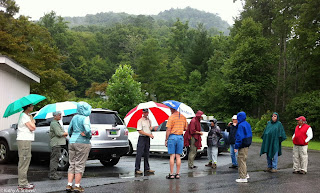The rain did nothing to dampen our enthusiasm for viewing the splendid display of orchids and other blooming wildflowers as Don Fisher led us around the grounds of Coweeta Hydrologic Lab. Don did an amazing job of scouting out these illusive orchids and conducting us through the areas where we could see the treasures.
The Orchids we were hoping to see included Three Bird (
Triphora trianthophora), Rattlesnake Plantain (
Goodyera pubescens), Green Wood Orchid
(Platanthera clavellata), Leaves of pink ladies slipper (
Cypripedium acaule), Crane fly (
Tipularia discolor), Slender ladies tresses (Spiranthes gracilis), and Yellow Fringed Orchid (
Platanthera ciliaris (L.) Lindl.).
We were treated to the sight of the very rare Three Bird Orchid (Triphora trianthophora) or Nodding Pagonia right at the start! This was such a treat because it is so small and inconspicuous that it's extremely easy to miss so it takes someone with an expert eye, like Don, to even notice them. It only blooms for one day so you most often see either the bud unopened or the spent bloom. It's usually no taller than 8 inches in height and likes acid soil, particularly hemlock forest. It gets it's name from the fact that when it's in bloom, it looks like three tiny birds have their mouths open for food or it resembles three birds in flight--I've heard it described both ways. I'm guessing a birder was involved with the naming of this orchid? There's a great article here HERE and another one HERE if you want to read more about it.
|
 |
| Three Bird Orchid by Karen Lawrence |
 |
| Three Bird Orchid Photo by Karen Lawrence |
From there we were fortunate to view examples of all of the orchids on our list! The moist woods was the habitat for the Rattlesnake plantain, the Green wood, Crane Fly and the leaves of the pink ladies slipper.
 |
Downy Rattlesnake Plaintain; Goodyera pubescens
The triangular spike of flowers is tightly pack on top third of stem. Flowers are small and rounded. This orchid is the most prolific we have in the southern mountains and can be found in virtually every habitat. There is a network of markings on each leaf which resembles the network of scales on the head of the rattlesnake.
|
 |
Green Woodland Orchid; Plantanthera clavellata Also called Club Spur Orchid
Club spur refers to the swollen or enlarged tip of the spur of each flower. The slender backward extension of the lip is often referred to as the nectary. The flowers are small and rounded and often oriented in different directions. This orchid is often inconspicuous because of green color and slender appearance which blends with background. It can reach up to about 10" in height. It usually displays only one narrow leaf partway up stem. It can be found in wet areas of open fields or woods. It blooms about the same time at the Diana fritillary butterfly begins to be seen on thistles.
|
 |
Cranefly; Tipularia discolor-
So named because individual flower somewhat resembles the cranefly. Individual flowers have a long slender spur. A solitary leaf which appears in the winter is dark green on top and bright purple or beet red on bottom. The leaf is not present during flowering. They bloom in summer in dark woods and often go undetected. There are three species of this genus in the world, yet only one occurs in North America. It often has a preference for woods with beech trees.
|
The nearby roadway was the site of the slender ladies tresses and a magnificent grouping of the yellow fringed orchid which happens to be my most favorite! it is truly an awesome display and visible from your car! I took a friend out there Saturday and we were able to view them easily from the car without disturbing a single blade of grass.
 |
Slender Ladies Tresses; Spiranthes lacera photo by KL
Plant has a green lip marginally edged with white. The scientific name refers to the small lacerations on edge of lip and to the spiraling pattern of flowers as they ascend the stem. This pattern is reminiscent of braided hair. Basal leaves may be absent at flowers. This is the second largest genus of orchids in our mountains, second to the fringed orchids-Plantanthera.
|
 |
Yellow Fringed Orchid; Plantanthera ciliaris by Karen Lawrence
Some refer to this as orange fringed orchid due to its appearance. It is fairly common in our southern mountains in early to mid August but is susceptible to even small habitat changes. Look for it in open sunlight in somewhat damp conditions or even dry sand. Most healthy plants reach heights up to 15". Most flowers open from the bottom up.
|
In addition to the orchids, we also saw the following:
Everlasting pea which was grown by Thomas Jefferson at Monticello back in 1807, Sumac, Virgin's Bower, Boneset, Fleabane, Sundrops, Coreopsis, Brown Nut, Colic Root, Rose Pinks and meadow beauties.

 |
| Looking at Three Bird Orchid |
 |
| It was very tiny |



Compiled by Kathy Stilwell












































What a great write up - like being there again!
ReplyDelete